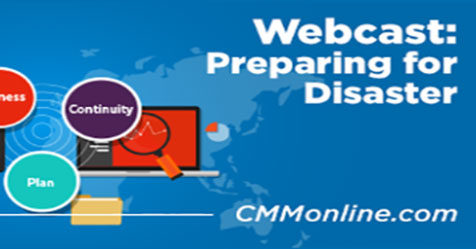If you’re a small business owner, “your financial life is on the line all the time,” says business coach and consultant Larry Galler. There is no way to predict what each day will bring, so a responsible owner, manager, or executive must always be prepared for the unexpected.
Contingency planning is one way to make sure you are ready to react when the unimaginable occurs. This advice doesn’t just apply to contract cleaning executives, though; it applies to any type of facility service provider, including in-house facility professionals. While small business owners may have to sweat it out over slow- or late-paying clients, both in-house and contract cleaning managers know what it’s like to deal with the fallout of transient staffs or supplies that don’t show up when needed. There’s always a possibility of vital equipment or building systems unexpectedly breaking down, structural damage when acts of nature occur, fire, flood, you name it. The possibilities are endless.
Whether you are the owner of a contract cleaning organization or the facility manager for a school or health care facility, a whole slew of things can go wrong on any given day that can throw a wrench in your operation, which in turn, may impact your budget and cash flow. Here are some proactive tips to help you prepare for and navigate those turbulent times.
Apply for a Line of Credit
While your organization may prefer to budget for contingencies with available cash flow, remember there is no way to know in advance how much your emergency is going to cost. “You don’t know whether the contingency is going to be ‘Oh my God, we ran out of paperclips’ or ‘Oh my God, the roof is falling in,” Galler says, “so you don’t have a clue as to how much of a budget you really need to set aside.” This is when applying for a line of credit can help you out.
If you haven’t already, discuss obtaining a line of credit with your bank, and as long as the conditions are agreeable, secure it. This way, if a situation arises that puts you in dire straits and you need that money to pay your staff or replace a piece of equipment, you can draw on it to get you over the hump until you have the cash in hand. “If you’re not prepared and you don’t have that [line of credit],” Galler says, “then all of the sudden … you’re running like crazy to try and find assets that you can to turn into cash.” To make matters worse, this detracts your focus away from other pressing obligations.
There is a chance you may never need to draw on the loan, Galler says; however, having access to an emergency line of credit that is flexible, has short-term financing options, and is just a phone call away will prevent you from having to take a chunk of liquid cash out of your annual budget. Just be sure your organization would be able to meet the terms of the loan before drawing on it or committing to any terms of agreement.
Invest in Preventative Maintenance
When a machine or system breaks down, it can be a costly endeavor for a facility. Depending on the extent of the repair—or if the equipment needs to be replaced altogether—the organization may be looking at a hefty and unexpected price tag. And sometimes, the cost may end up being more than it initially seems.
“The real expense isn’t always the cost of the damaged structure,” says Timothy Hull, director of operations for restoration and cleaning consultancy Violand Management Associates, but rather, “the business interruption, loss of use, or loss of income associated with the peril that is the most costly expense.”
With Hull’s point in mind, consider the following: Will a broken HVAC or furnace prevent patrons from coming back to your facility? Will they then write a negative review about their experience? Will internet and network problems prevent business and income-driven transactions from taking place? Will flooding or leaks created from structural damage prevent people from using the facility at all? At the end of the day, the cost of these types of disruptions can be astronomical.
In a 2017 survey of more than 800 users from research and consulting firm Information Technology Intelligence Consulting, 81 percent of organizations reported a single hour of downtime with mission-critical systems cost them more than US$300,000. What if that single hour of downtime could have been prevented in some cases?
Preventative maintenance and routine inspections of major mechanical systems can help to mitigate potential downtime from failing equipment or systems, Hull says. Similar to how one would put matting down in a building entryway to help preserve carpet, preventative maintenance for all types of equipment and systems can help prolong the life of your assets, allowing your organization to get the most bang for its buck and plan for future expenditures accordingly.
At the same time, it’s important to evaluate the return on investment (ROI) when deciding to move forward with maintenance of a system. “If preventative maintenance costs exceed the cost of an expected repair, then the maintenance isn’t worth the investment,” Hull says. “However, if the preventative maintenance costs significantly reduce the risk of a loss occurrence, then the ROI is worth it.”
Invest in Mitigation Strategy Tactics
As of July 9, 2018, severe weather conditions, such as storms and blizzards, across the United States have totaled more than $7 billion in damages for 2018. These types of events can be catastrophic for organizations, and they aren’t necessarily predictable.
While facility service providers can’t control the weather, they can control how they prepare for and respond to it—which, in the end, can have a huge impact on an organization’s bottom line. Hull recommends securing emergency service contracts and disaster response plans with restoration contractors. “As response time can be a big advantage to minimizing loss,” he says, “having this commitment with an emergency contractor gives both parties an advantage in working toward the common goal of getting the building back in business sooner.”
Organizations can also control unpredictable damage costs by having the right insurance policies in place. For example, a 2017 CMM article on disaster planning notes while flood insurance won’t actually prevent the water from coming into a facility or damaging equipment, “it will lessen your associated financial losses.” Insurance plans can also help to protect businesses from messy and unpredictable liability claims that may stem from an on-site accident.
Pay Now or Pay Later
Following these principles will allow organizations to work contingency planning efforts into their annual budgets by adding line items to cover regular facility maintenance projects and insurance premiums, instead of winging it when a hefty capital project comes up. And if you need help covering the deductible when the insurance claim is necessary—well, maybe that’s when the line of credit can come into play.




